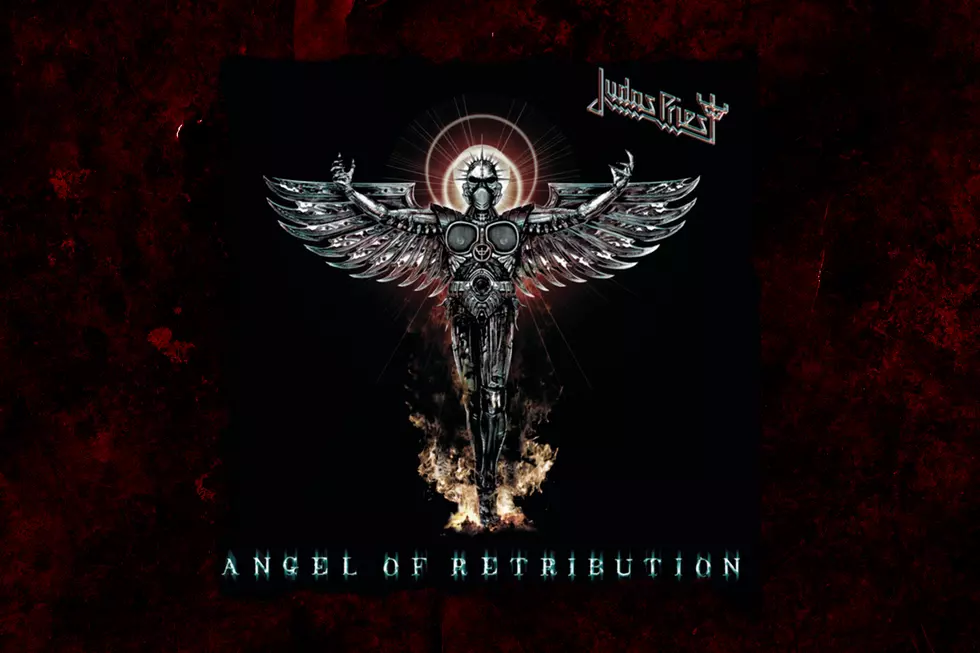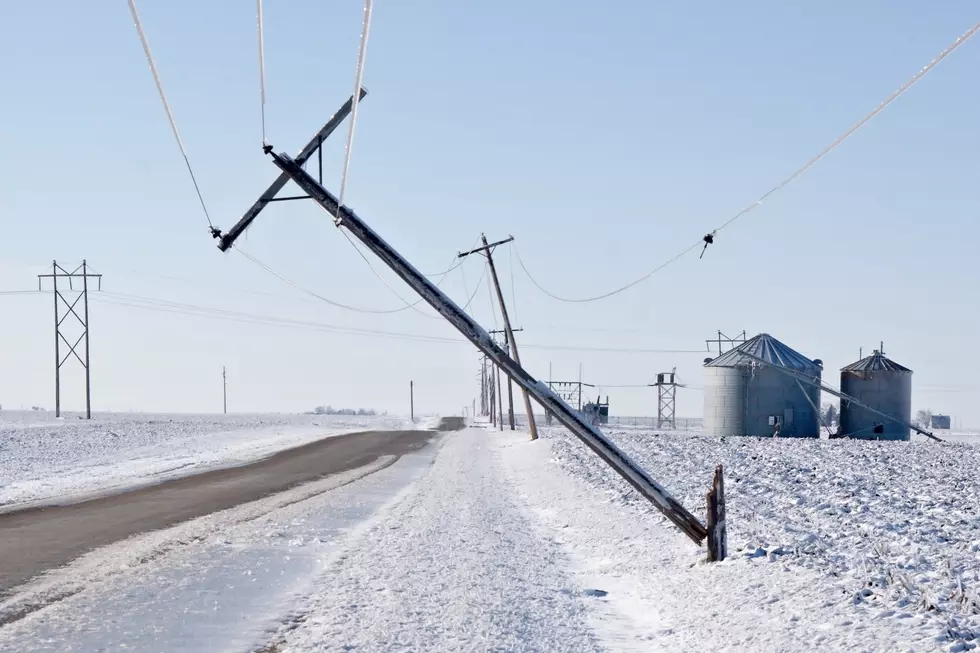
18 Years Ago: Judas Priest Release Reunion Album ‘Angel of Retribution’
In so many ways, Judas Priest’s career has been defined by comeback moments. This is the band that followed up their 1980 breakthrough, British Steel, with the lackluster Point of Entry, from which they rebounded on the defiant Screaming for Vengeance. Then there’s the triumphant Painkiller that came in the wake of the experimental and synth-laden Turbo and Ram it Down. But the biggest challenge of all was mounting the metal summit once more after a long-awaited reunion with frontman Rob Halford was marked by Priest’s first album with the Metal God since 1990, Angel of Retribution.
Released on Feb. 28, 2005, Angel of Retribution arrived adorned with the chromium-plated metal monster fans saw tearing through the sky 15 years earlier on the cover of Painkiller. This instantly established the reunion album as a natural successor to where Halford and the band had last left off while the digitized render also asserted the notion that Priest’s vision was equally entrenched in the modern day.
After all, they had just finished up a run on Ozzfest prior to the album’s release and were armed with a new generation of fans who might not be so easily convinced by a band imitating past glories. Of that experience, the Metal God told Loudwire, “We always take the energy and reaction from the set as something of a focus to remind us about the journey we are on. Those feelings live inside you and you utilize them when you return to the studio. Knowing where to go next is instinctive for us.”
Judas Is Rising
“Forged out of flame, from chaos to destiny”
Metal, in its authentic state, felt very much alive by 2005, especially when considering the fallout of ’80s greats in the ’90s. Nu-metal was fading out of style and the metalcore explosion of ’04 signaled a fresh and exciting direction without all that made-for-MTV hullabaloo.
Halford, after a wayward career outside of Judas Priest that included his groove metal band Fight and his ill-fated attempt at industrial with 2wo, had reclaimed his identity as the Metal God on two ripping, unwavering heavy metal solo albums — 2000’s aptly-named Resurrection and the daringly heavy Crucible from 2002, sandwiched by Live Insurrection where he also belted vintage Priest classics with renewed power.
From the outside fan perspective, it’s difficult not to see lyrics such as “I walked alone into a fight / No longer standing in Satanic light / I tried to look too far ahead / And saw the road go to my past instead” from “Resurrection” as anything but tolling the reunion bell.
Judas Preist, "Resurrection" (Live)
Halford, though, has a more holistic mindset when looking back on that song specifically, telling Loudwire, “It’s a declaration of my love and commitment to metal. You can build bridges with music and this song did that.”
The singer even stated in his Confess autobiography that his split with Priest was due to an overwhelming miscommunication and he never truly wanted to be apart from the group to begin with, so returning to front the metal legends was certainly a desirable outcome.
As high profile of a reunion as this was, it actually came together rather unceremoniously behind the scenes with that pending Ozzfest offer from Sharon Osbourne helping to spur things into action.
Time for Retribution
“If you think it’s over, better think again / There’ll be no compromise”
With the Metal God seated once more at the throne of Judas Priest, the band began working with producer Roy Z, a familiar of the singer’s who had produced his aforementioned pair of solo records. He had also worked with Bruce Dickinson and played on his two solo albums that were released prior to him rejoining Maiden in ’99, a coincidence with little significance but a peculiar one nonetheless.
The inherent pressure here is defining what a reunited Judas Priest sounds like in 2005. With Tim ‘Ripper’ Owens, Halford’s replacement, the long-running metal group forged a different sound across the Jugulator and Demolition albums — one that veered far from their recognizable hallmarks and appeared to cater, in part, to the groove trend dominating metal at the time. And, well, there’s a reason we’re talking about a reunion, right?
Besides, Priest had spent the entirety of the first Halford era keeping pace with advances in heavy music and the occasional slip away from it (ehemm… those guitar synths) — this was a chance to cement the Judas Priest legacy in their self-defined, time-honored sound and step foot back on the same trail they had spent almost 20 years blazing together already.
“It was pretty easy with Rob in the same room,” guitarist K.K. Downing told The Aquarian in 2005 after the album’s release. “Everything he sang sounded like everybody wanted it to sound like — like Halford’s voice. Pretty much everything you do with Rob’s voice on there sounded like Judas Priest, so that made it a lot easier, as opposed to Ripper singing and, ‘Oh it’s good, but are people going to accept it?’ or whatever.”
Hellriders
“Here they come, these gods of steel”
Angel of Retribution boasts a booming modern production, which easily distinguished the reunion as something bona-fide and forward-thinking. Beyond the walls of distortion (felt considerably on the roaring “Demonizer”), this production value benefitted the softer end of the spectrum, too, on the ballad “Angel” and parts of the contemplative “Worth Fighting For.” Rather than dating these songs as products of decades gone by, the delicate guitar tones are presented with such of-the-moment clarity that they can’t simply be branded as obvious ’70s throwbacks.
A sort of greatest hits approach in regards to style, Priest used variety to pay homage to some of their most regarded works. For the most ardent of headbangers, “Demonizer,” “Judas Rising” and “Hellrider” were nods to Priest at their most full-throttled, while the more rock-steady “Revolution” and “Wheels of Fire” leaned in a slightly commercial, arena-built direction with the former garnering plenty of radio airplay.
Judas Priest, "Judas Rising"
And, yes, there was even room for something a bit new — the winding, 13-minute opus “Lochness.” Here, Priest tip their hat to fellow Birmingham mates Black Sabbath with a doom-laden, cinematic tribute to the enigmatic creature of the deep, the mythic Lochness Monster. It’s a polarizing effort and one that was poorly received around the album’s release, but has fared a bit better with age. At the least, it’s an intriguing song in context of the immense, hundred-plus song Judas Priest catalog.
Lyrically, Halford’s battle-tested themes were the sticking point on this marvelous return to form and gone were feeble-worded worries and painfully bad puns about the cyber age (“Don’t access the site / Or beware his megabyte” from Demolition’s “Cyberface”).
Angel of Retribution also saw the return of fabled priest characters — the Sentinel, the Painkiller — as well as references to past albums and titles — “Ram it Down,” Stained Class — of which Halford commented, “Priest built a foundation of unique characters that represent us. The opportunities to find new directions within that world are endless. Change is something we seek on every album, be it be blunt or subtle. The past can move you forward.”
Not only do these redemptive themes align with tried-and-true Priest, but they also relay Halford’s own experiences since first exiting Priest — pursuing a career built off his name alone and later coming out as a gay man on MTV in 1998.
Rob Halford's Coming Out Report on MTV
“You see the overriding stories of optimism and the overriding stories of defeating anything that stands in your way, that prevents you from achieving your goals or your dreams,” the singer told NPR in a 2005 interview. “A lot of the lyrics I write for Priest come from this streak that I have inside of me, which has always been one of determination and overcoming the odds.”
Eulogy
“So it goes forever more, ever steady to the core”
The only real knock here is maybe Angel of Retribution doesn’t have the firestorm sequencing of the hallowed classics Screaming for Vengeance or Painkiller, but, again, it’s not as if Priest needed to forge an entirely new sound and direction.
What was needed was exactly what Priest built with these 10 tracks, which was a categorical overview of the entirety of the Judas Priest sound — Scott Travis’ double-kick fed drums, twin guitar leads, mid-tempo rock belters, the poignant ballad or two and the unmistakable voice and range of the self-proclaimed Metal God.
That fresh, inspired and bold direction hinted at on the closer “Lochness” came next on the conceptual double album, the divisive Nostradamus. The irony there is that the song was actually about 20 years in the making. “The fact that a good idea lingers as it did for over two decades before we got around to make it,” is what Halford said stands out about the song the most today. “Once we began writing, the theme took on a life of its own and became as big as the metal monster itself.”
Judas Priest, "Lochness"
If you’re reuniting for the fans’ sake, or at least in part, there’s an inherent debt to pay, which is to please fans of any era of Judas Priest (okay, maybe less so regarding the Ripper era). Whether that’s how the band views it is a different matter altogether, but, ultimately, it’s the fans who assign value to the music.
It’s fair to say that debt has been readily collected by decades of Priest fans. And, 16 years later, that metal monster continues to swell in size as Judas Priest continue writing what will be their 19th studio album and the successor to 2018’s Firepower.
See What 28 Rock + Metal Stars Look Like in 'The Simpsons' Episodes
More From KZCD-FM










